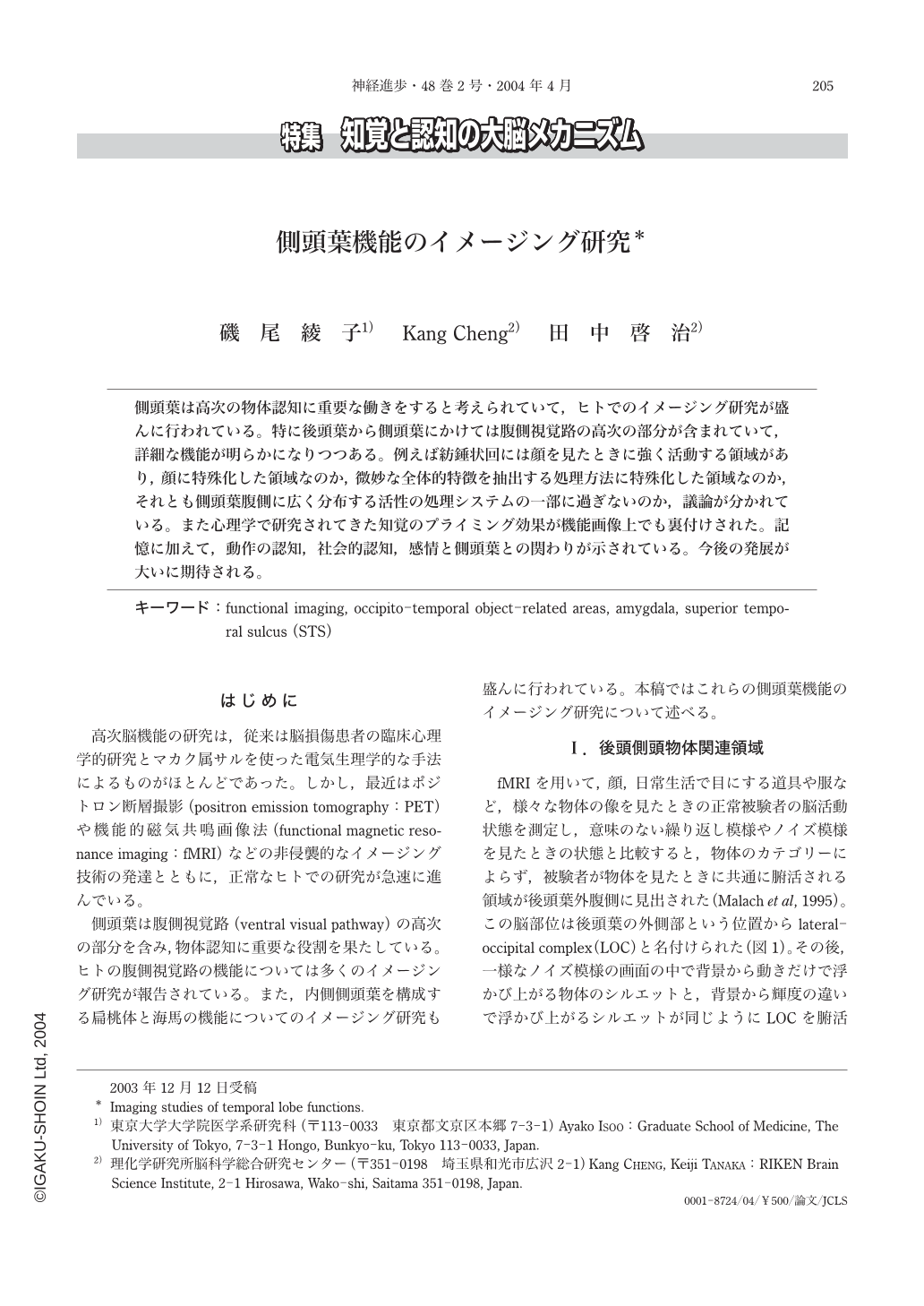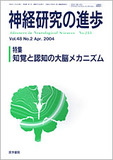Japanese
English
- 有料閲覧
- Abstract 文献概要
- 1ページ目 Look Inside
側頭葉は高次の物体認知に重要な働きをすると考えられていて,ヒトでのイメージング研究が盛んに行われている。特に後頭葉から側頭葉にかけては腹側視覚路の高次の部分が含まれていて,詳細な機能が明らかになりつつある。例えば紡錘状回には顔を見たときに強く活動する領域があり,顔に特殊化した領域なのか,微妙な全体的特徴を抽出する処理方法に特殊化した領域なのか,それとも側頭葉腹側に広く分布する活性の処理システムの一部に過ぎないのか,議論が分かれている。また心理学で研究されてきた知覚のプライミング効果が機能画像上でも裏付けされた。記憶に加えて,動作の認知,社会的認知,感情と側頭葉との関わりが示されている。今後の発展が大いに期待される。
Functional imaging studies using positron emission tomography(PET)and functional magnetic resonance imaging(fMRI)have greatly advanced our understanding of sensory processes and cognitive functions in human temporal lobe. A large number of impressive and consistent results, as will be selectively reviewed here, have been achieved concerning the functions and modular representation in occipito-temporal object-related areas, importance of the superior temporal sulcus region(STS)in social cognition, involvement of the amygdala in emotional processing, and roles of hippocampus in the formation of memories.
The occipito-temporal cortex, including high-order areas in the ventral visual pathway, is important for object recognition and conscious vision in general. Convergent PET and fMRI studies have revealed several object-related areas in the occipito-temporal cortex, including the lateral occipital complex(LOC). A few specialized areas, such as fusiform face area(FFA)for faces, parahippocampal place area(PPA)for scenes and buildings and extrastriate body area(EBA)for human bodies, are also identified, but it is still controversial regarding their exact functions. For example, one explanation argues for the existence of independent modules for coding different visual categories and FFA is specialized for face recognition, another argues that FFA is not specialized for face perception per se, rather, its activation depends on a subject's expertise with a given object category, and more recently, it is argued that objects are represented in a distributed and overlapping fashion across object related areas and a distinct pattern of response can be found for each object category.
Priming effect has also been studied in temporal cortex. In contrast to previous findings that priming in general causes decreased activation, it is shown recently that by slowing down the recognition process, which produces a shift in the time of peak activation, priming results in increased activation before recognition is achieved.
STS integrates information from both dorsal and ventral visual pathways and is involved in analysis of biological motions such as the gaze of eyes and movements of the eyes, mouth, hands and body of other individuals. Interconnected brain regions, including STS, amygdala and orbitofrontal cortex, are shown in several studies to be important for social perception and cognition that influence the moral judgment. STS, together with the anterior paracingulate gyrus and temporal pole, is also activated by stimuli and tasks related to“theory of mind.”
Emotions are broadly divided into basic emotions such as fear and moral emotions such as guilt. A network of brain structures participates in processing emotions. The amygdala, in cooperation with the ventral striatum and orbitofrontal cortex, is extensively involved in the processing of emotions, especially basic emotions. Emotions are processed in several stages and the amygdala has been shown to be a key component participating in both the early and later stages of emotional processing.
The hippocampus plays important roles in encoding and consolidation of newly formed memories, and the parahippocampal gyrus plays a specific role in modulating memories provided by the stimulus novelty. Together, the hippocampus and parahippocampal gyrus contribute much not only to the formation of visual memory but to the formation of memories in general.
In summary, temporal lobe plays a primary role in object recognition. However, the goal of this processing goes beyond mere identification and recognition of objects;it is used to guide our behaviours by making proper social judgment and forming memories. Temporal lobe, especially high-order regions, differs greatly in monkeys and humans and the knowledge from monkey studies cannot be directly applied to humans. In this regard, functional imaging has an advantage in studies of cognitive functions of human temporal lobe. More exciting and productive results are expected in the near future.
(Received:December 12, 2003)

Copyright © 2004, Igaku-Shoin Ltd. All rights reserved.


